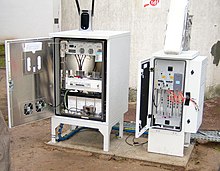
Back WiMax Afrikaans واي ماكس Arabic WiMAX Azerbaijani WiMAX Byelorussian WiMAX BE-X-OLD WiMAX Bulgarian ওয়াইম্যাক্স Bengali/Bangla WiMAX BS WiMAX Catalan WiMAX Czech
It is proposed that this article be deleted because of the following concern:
If you can address this concern by improving, copyediting, sourcing, renaming, or merging the page, please edit this page and do so. You may remove this message if you improve the article or otherwise object to deletion for any reason. Although not required, you are encouraged to explain why you object to the deletion, either in your edit summary or on the talk page. If this template is removed, do not replace it. The article may be deleted if this message remains in place for seven days, i.e., after 23:41, 30 June 2024 (UTC). Find sources: "WiMAX" – news · newspapers · books · scholar · JSTOR Nominator: Please consider notifying the author/project: {{subst:proposed deletion notify|WiMAX|concern=This article is misleading, failing to mention that this is obsolete technology that ultimately lost a [[format war]] to 4G and 5G networks. It's haphazardly structured, reads like an advertisement in places, and more concerningly, has had update templates saying it's overly jargon-heavy since 2010 (14 years!!) and needs update since 2019 (5 years ago). Many of the sources are from the 2000s and it's full of references to future deployments which almost certainly don't exist. It could be a candidate for rewriting rather than deletion, but frankly, I suspect it's so much work it'd be faster to start again from scratch.}} ~~~~ |
This article has multiple issues. Please help improve it or discuss these issues on the talk page. (Learn how and when to remove these template messages)
|
 |

Worldwide Interoperability for Microwave Access (WiMAX) is a family of wireless broadband communication standards based on the IEEE 802.16 set of standards, which provide physical layer (PHY) and media access control (MAC) options.
The WiMAX Forum was formed in June 2001 to promote conformity and interoperability, including the definition of system profiles for commercial vendors.[1] The forum describes WiMAX as "a standards-based technology enabling the delivery of last mile wireless broadband access as an alternative to cable and DSL".[2] IEEE 802.16m or WirelessMAN-Advanced was a candidate for 4G, in competition with the LTE Advanced standard.
WiMAX was initially designed to provide 30 to 40 megabit-per-second data rates,[3] with the 2011 update providing up to 1 Gbit/s[3] for fixed stations.
WiMAX release 2.1, popularly branded as WiMAX 2+, is a backwards-compatible transition from previous WiMAX generations. It is compatible and interoperable with TD-LTE. Newer versions, still backward compatible, include WiMAX release 2.2 (2014) and WiMAX release 3 (2021, adds interoperation with 5G NR).
- ^ Pinola, Jarno; Kostas Pentikousis (2008). "Mobile WiMAX". The Internet Protocol Journal. Cisco. Archived from the original on 2016-08-21. Retrieved 2016-08-05.
- ^ "WiMax Forum – Technology". Archived from the original on July 22, 2008. Retrieved 2008-07-22.
- ^ a b Carl Weinschenk (April 16, 2010). "Speeding Up WiMax". IT Business Edge. Archived from the original on 2011-09-05. Retrieved August 31, 2011.
Today the initial WiMax system is designed to provide 30 to 40 megabit-per-second data rates.
© MMXXIII Rich X Search. We shall prevail. All rights reserved. Rich X Search